Butler Blood Relations
The Butler Bloodline's Influence on the "Seven Families"
By Kaso Kety
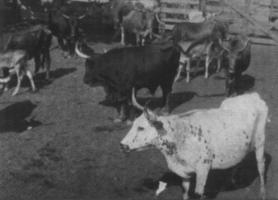
Top photo: Sunnu Girl, a Milby Butler-branded cow used by the Wright family. Above: A group including WR 24 (white cow in foreground) awaits shipping in Devers, Texas to the Wichita Refuge in 1927. These females were among the 20 head of foundation cows selected by Hatton and Barnes to form the WR herd. |
In recent years, as an ever-increasing number of breeders introduce or increase the amount of Butler breeding in their herds, I have found myself confronted by other breeders who are hesitant to jump on the Butler bandwagon. Having heard for many years a variety of propaganda and misinformation about the bloodline, they were confused-the Butler cattle topping sales around the industry seemed to have little in common with the stereotyped "small, white cow" of the past. My response is simply that this is a very diverse breed containing many different kinds of cattle. People should raise the kind that appeals to them-if that kind happens to be Butler Longhorns, then all the better.
The response to my statement that "Maybe the bloodline that was good enough for Jack Phillips, Graves Peeler, the Marks and Wright families and the WR program just might have something to offer you" is generally a combination of shock and disbelief. In this article, however, I will illustrate the fact that five of the other six accepted "families" of Longhorns introduced Butler breeding into their programs at some point in the past (the Yates family is the one with no known use of Butler blood in its history)..
This is not to say that the Butler the dominated the Peeler, Phillips, Marks, WR and Wright bloodlines, or changed the inherent qualities already existing in these herds. Nor did Butler cattle rush in to save these bloodlines from extinction; they were simply seen as quality outcross blood. It is, however, interesting to attempt to document where and when these introductions occurred in order to gain a better understanding of the genetic interactions of seemingly unrelated groups. As breeders become more knowledgeable about the genetic backgrounds of their cattle, they acquire the tools necessary to create matings that will hopefully result in better cattle, not just more cattle.
Butler cattle introduced into the other families still hold close relationships to Butler cattle today. By studying the interactions of modern Butler sub-families, breeders can discover valuable clues as to which matings will work best. Much time has passed and in some cases people's memories are our best sources of information, but with the help of old photos we gain glimpses that reveal just how important a role the Butler bloodline played in the resurrection of the Texas Longhorn breed.
Phillips, Peeler Families Gain Butler Blood
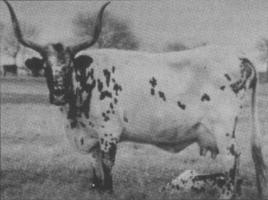
King Ranch 124, displays telltale signs of the Butler influence on the Peeler bloodline. |
The introduction of Butler blood into the Phillips and Peeler herds occurred when Milby Butler quite unknowingly and unintentionally sold a bull to Jack Phillips in 1951. The bull was a herd sire prospect Milby had been keeping, but the bull's repeated and ingenious escapes from his confinements left Butler little choice but to rid himself of this aggravation by selling the bull. Milby was very particular about his cattle and rarely sold any unless he had come to know the buyer quite well. This, plus the fact the bull had been a terrible nuisance resulted in a trip to the Port City Stockyards at Sealy, Texas.
Milby consigned the bull with the stipulation that he only be sold for slaughter. A friend of Jack Phillips, working as a buyer for the Blue Ribbon Packing Company, purchased the bull and knowing of Phillips' interest in good Texas Longhorn cattle, called him with a description of the bull and a deal was made. The bull was described as a big, flat horned individual with mottled brown coloring, a mealy nose and lighter colored brown rings around each eye. Phillips was quoted as saying "I put him out with cows and he never gave me a lick of trouble. We raised a lot of cattle sired by him and he did us a lot of good."
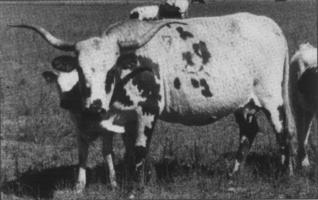
Brazos Belle 12 (shown here with Bold Brass at side) was sold by Jack Phillips to Chico Wright. The cow's distinctive coloring is evidence of the Butler influence. |
Jack Phillips and Graves Peeler were very good friends and regularly exchanged or shared cattle over the many years of their friendship. Such was the case of the Butler bull. The bull was alternated between the two and lived "to a ripe old age." To try and determine the extent of this bull's impact on the Peeler herd would be nothing more than pure speculation. Both herds were multi-sire, but from Phillips' description of the bull as a dominant bull and considering his longevity, it is quite possible that the bull had, at least during the mid 1950's, a substantial influence on the Peeler herd. As pure Peeler cattle have become more and more difficult to find, it also becomes more difficult to determine how much remains, yet from cattle dating to the 1960's and 70's numerous examples could be found that displayed definite clues to their ancestry.
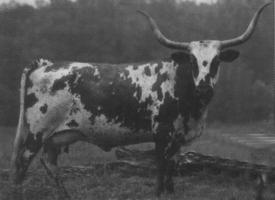
The beautiful and exotic red and white color pattern of Duchess Anne, a straight-Butler cow, is strikingly reminiscent of the coloring of the Phillips/Butler cow Brazos Belle 12 above. |
Texas Ranger JP: 25% Butler?
While we can only guess about the Peeler herd, the Phillips herd is a little different. I had the pleasure of visiting with Mr. Jack Phillips after the first Ark-La-Tex Cajun Classic Sale in Shreveport, Louisiana. We had just purchased one of his consignments and told him that we were using Butler bulls and wondered what kind of results we might expect. This led to a conversation about his Butler bull in which he stated that the bull had a substantial impact on his herd and in fact he was very confident that Texas Ranger JP himself went back to the old bull on his dam's side. I asked him about the possibility that Ranger could be double-bred to the Butler bull, a story I had heard. He said that in a day of multi-sire herds he could have been, but although he felt very strongly that Texas Ranger only went back to the Butler bull on his mother's side, he was convinced that Texas Ranger JP was at least one-quarter Butler!
In later conversations with Terry Kelsey and Darol Dickinson, both expressed their belief (backed by years of studying and raising Texas Longhorns) that Texas Ranger JP was in fact part Butler. Interestingly, Texas Ranger was used quite regularly on Butler cows in the Kelsey and Dickinson programs. The three men that knew this great bull best (Phillips, Dickinson and Kelsey) all agree that Texas Ranger JP-a bull that ironically symbolized non-Butler breeding in the "Texas Ranger vs. Butler" wars of the late 1980s-early '90s-owes at least a part of his genetic greatness to Butler breeding. If this is true, as these men believe it is, the magnitude of the Butler influence on the Phillips blood line becomes truly monumental. Today, Phillips breeding is generally referred to as Texas Ranger breeding, as most of the cattle that remain go back to Ranger.
Butler Breeding Finds its Way into the Wright Herd

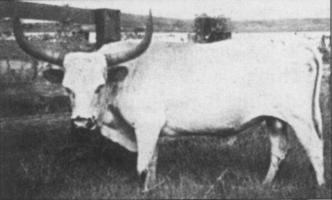
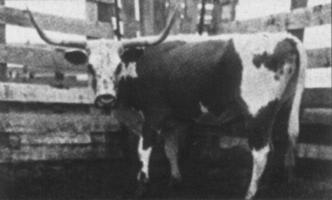
Somewhat, Goliath II and Smart Girl "Troutline", three members of the Wright herd, had Butler-branded dams. |
Butler breeding originally made its way into the Wright Texas Longhorn herd by way of the first TLBAA sales. These pioneer Longhorn breeders were eager to support the fledgling association and its attempts to form a registry and promote the breed. In this spirit they enthusiastically consigned and purchased cattle at these association sales. In sales at Houston and San Antonio, Milby consigned groups of heifers and the Wrights were the buyers. These appear to have been done in groups of five or ten. It is difficult to tell because hand-written entries in old sale catalogs indicate the vagueness of the offering (a pen of heifers consigned by Milby Butler) and last minute additional consignments.
The first group seems to have been five two-year-olds already branded and registered by Butler with private herd numbers in the 230's and 240's. As Milby's health declined he was not able to keep up with the paperwork like before. A second sale of heifers, year lings or two year olds and five to ten in number took place. These appear not to have been branded and were therefore branded by the Wrights and hardship registered as unknown Wright Long horns, when they were in fact straight Butler. Their private heard numbers appear to start at around 130 and increase from there.
The Wright family regularly bought cattle from many sources and for years boasted the largest herd of registered Longhorn cattle. It becomes readily apparent that from those first groups of Butler heifers, to the later use of Bold Ruler breeding-Butler cattle have played a major role in the formation and development of the Wright family of Texas Longhorns.
Unlike some of the other herds, Butler breeding had a profound and lasting effect on the Wright herd. Sons and grandsons of the Butler cows were used as herd sires and many a Wright-bred bull can be found carrying Butler genetics. Since bulls contribute half of the genetics to each calf crop, one can easily see how quickly this breeding can become pervasive in the genetic makeup of a herd. M.P. "Chico" Wright III was quoted as saying "We bought some Butler cows in the first TLBAA sales. That white color with the red or black ears became the most dominant color in our herd." Some of the greatest Wright cattle trace directly to this heritage including cows such as Somewhat and Smart Girl (Troutline) and bulls such as Goliath II and Locksmith.
In later years the Wrights purchased and used Bold Ruler with great success. As the bull's popularity rose, many a Wright-bred Bold Ruler daughter could be found topping Longhorn sales around the country. The Wrights then purchased the Bold Ruler son, Ticonderoga, out of the Texas Ranger/WR bred cow, Piccadilly. Many of the last Chico Wright-bred cattle include Ticonderoga in their pedigrees.
Pete Leaves His "Marks" On LH7 Ranch Herd
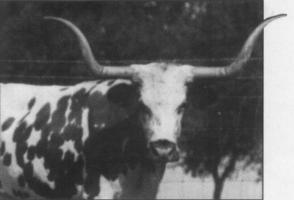
Miss Guadalupe 317, bred and raised by Travis Marks, exhibits the distinctive red and white color pattern brought into the herd by Butler breeding. |
The first TLBAA sale in Houston in 1967 served as the backdrop for the Marks' acquisition of Butler breeding. Travis Marks and his father Emil (also known as E.H.) were two of the volume buyers and during the course of the sale Travis purchased a young, straight-Butler bull from Blackie Graves named Pete. Blackie had begun raising Butler cattle some five years prior and while his herd was still small he consigned the bull to support the sale. Pete was sired by Sam, Blackie's original bull, and his dam was Miss Dayton 2, a foundation Butler cow. The bull was transported to the ranch at Barker and used on the LH7 longhorn herd. During this time another bull, a WR bred bull from Oregon breeder Harry Pon, was also being used by Marks.
After Emil Marks died in 1969 the cattle were divided among the Marks heirs, with Travis Marks doing his best to "get the papers straight" on his father's cattle. As often happens, however, some mistakes undoubtedly occurred in the registrations of Pete offspring and those of the Pon bull (Mr. Mischief), though it appears that more Pete progeny were registered as Mr. Mischief calves than the other way around.
While this confusion makes it impossible to judge the true impact of Pete on the Marks herd, the bull did leave his potent and telltale signs of Butler genetics pulsing through the veins of many great Marks-bred cattle. Females showing the greatest amount of this influence seem to have private herd numbers in the 300s. Many of Travis Marks' advertisements for the LH7 Ranch feature Pete descendants, which is one indication of the importance he placed on this breeding within the Marks program.
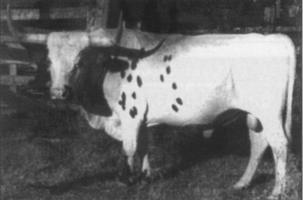
Blackie Graves-bred sire, Pete, purchased from Graves by Travis Marks and later owned--if only momentarily--by Johnnie Hoffman. |
In 1972 Pete was sold with a group of Marks-bred cattle (including several daughters) to J.H. Brazier, a Louisiana oilman who had a ranch near Palestine, Texas. This group of Longhorns included what is considered one of the all-time great Marks-bred cows, Miss Guadalupe 317.
Despite regular run-ins with the buffalo herd Brazier kept, the Pete bull led a peaceful life, bred and inbred to this small group of Longhorns for years until 1979 when Brazier decided to sell the cattle. At an oil convention the Brazier cattle came to the attention of one Johnnie Hoffman, who struck a deal for the entire group (which was to be picked up at the local sale barn).
While Pete was gentle in nature, years of abuse by the buffalo herd had made him deathly afraid of being penned and once penned would not stay (undoubtedly fearing another whipping by the buffaloes, with no hope of escape). When Mr. Johnnie arrived to take possession of the cattle it was found that Pete had escaped. He was finally "hemmed up" behind a Mexican fellow's house down near the river. Mr. Johnnie sized up the situation and did the only thing he felt he could with the bull being in a highly agitated state and no way to confine or control him. He borrowed the man's rifle and put the bull down with a single shot.
"It was probably one of my biggest mistakes in the Longhorn business," Mr. Johnnie later acknowledged. "I had no idea what I had until I told Blackie about it later and he told me just who Pete was. The only good thing was the Mexican man sure was happy when I told him he could have the meat."
Though Pete met a most inglorious demise, his breeding was to survive through some of the elite programs in the breed, including the Hoffman, Sparger, Blackie Graves and Red McCombs herds. While the extent of his influence in the Marks herd itself remains uncertain, Pete's legacy has lived on through the magnitude of the outstanding individuals that carry his breeding.
Butler Blood Diversifies WR Gene Pool

Bold Ruler, a Butler bull, was used on the Wichita Refuge as an "outcross" sire. The cow is WR 1850, one of the most famous WR cows ever. |
In 1976 a little-noticed event occurred at the Wichita Mountains Wildlife Refuge that would change Longhorn history for years to come. Longtime breeder and Longhorn innovator Darol Dickinson offered to loan the WR the breeding services of a coming three-year-old Butler bull to use on the refuge herd. The bull's name was Bold Ruler. Dickinson had acquired the bull as a calf from Blackie Graves, although the bull's sire and dam were both from Milby Butler's herd.
To achieve the consistency of type that the early Refuge managers sought, a great deal of linebreeding was done. This resulted in a uniform, "tight bred" herd, and only in very rare cases had any outcrossing been done.
Understanding this situation, Dickinson offered Refuge managers the use of this promising young bull to diversify the WR gene pool. Bold Ruler was not only the longest-horned bull for his age, but was in fact one of the longest in the entire breed.
Dickinson has all along been a strong believer in crossing unrelated bloodlines, even coining the term "blend genetics" to describe this type of breeding approach. Dickinson also felt that of the seven "families" of Longhorns, the Butler and WR herds were more similar in certain traits (primarily in regard to size and body type) than when compared to other Longhorn bloodlines.
Though Bold Ruler was only bred to a relatively small group-fifteen cows exposed resulting in thirteen calves (five bulls, six heifers and two steers)-his WR-branded progeny became some of the most sought-after in the breed with many becoming household names.
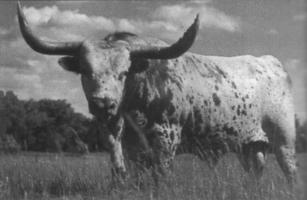
Rod's Husker (WR 3519), a Bold Ruler son born on the Wichita Refuge and a featured sire in the Jerry Gillespie program. |
Among the bulls were Rod's Husker (WR 3516), Ruler of Double H (WR 3519) and WR 3574 (used on the refuge for two years). The females were equally impressive and included WR 3550 (Boldana), WR 3469 (Parsley), Lily White and WR 3559. The WR 3559 cow still holds the auction record for a WR female, selling for $32,000 at the 1983 Wichita Refuge Sale.
Ironically, it was this very success that prompted a move among WR purists to purge the Refuge herd of all non-WR bred cattle including (but not limited to) Bold Ruler. Some viewed it as an unacceptable precedent to have the highest-selling WR cattle be half Butler. In discussing the Bold Ruler influence in the WR herd today, Refuge Manager Joe Kimball informs me that Bold Ruler descendants still exist in the herd, with no plans to eliminate them. Most of the animals trace back to the Bold Ruler daughter 3551. Her granddaughters and great-granddaughter as well as a grand son continue to carry on the legacy.
"I wouldn't presume to know more than the managers that came before me, and it's not my place to second-guess their decisions," says Kimball. "As long as the animals display the characteristics of the true WR type which we are dedicated to preserving, I see no reason to cull these animals from the herd. I wanted, however, to be able to say that this herd was visually inspected and bloodtyped for purity. This was consistent with the guidelines of the Cattleman's Texas Long horn Registry, so the herd was submitted for registration and was inspected." According to Mr. Kimball, every single animal with Bold Ruler in its pedigree passed both visual inspection and bloodtyping. So it would appear that after all the high-selling hype and caustic criticism of "mongrelized" pedigrees, Bold Ruler's WR legacy will be preserved because in the end he did all that could be expected of him-he produced good Texas Longhorn cattle.
Cow #24: The Missing Link to WR-Butler Mystery
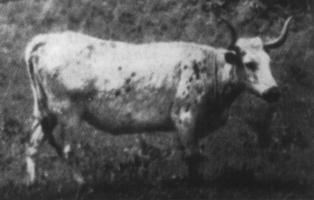
The unique coloring and general body type of WR 24 led to "reopening of the investigation" regarding the origin of the WR herd. |
In the preparation of this account I discovered many interesting facts that not only change common perceptions of Longhorn history, but that also have serious implications as to the genetic interactions of Longhorn gene pools. The following illustration of this involves the foundation herds of Milby Butler and the Wichita Refuge. Many people, such as myself, were taught early on that the two were as different as night and day, with very little in common. Despite a widely acknowledged Butler/WR "magic cross," purists on both sides maligned each other's cattle for years, finding little to agree upon except that both belonged to a very large and diverse breed known as the Texas Longhorn.
Her name was WR 24 and she has haunted me since I first saw her in an old photo of the WR foundation herd. From the moment I saw her, everything about her told me she was a Butler Texas Longhorn, or at least from the same gene pool. But how could that be? I had always been told that the herd was put together after a search of thousands of miles criss-crossing Texas and viewing in excess of 50,000 head of cattle from East Texas to the Rio Grande Valley to the Llano Estacado. But upon further research, I discovered something quite amazing.
The Wichita Refuge's twenty foundation cows were purchased in two groups. Nine were purchased in Devers, Texas, and eleven were purchased in Edinburg, Texas. WR 24 was purchased from Seth Brown in Devers (located between Liberty and Beaumont in East Texas). Described as "white with red specks," her arrival at the Refuge predates, by four years, the first introduction of the same distinctive coloring into the Butler herd. This color came to Milby's program in 1931 from the herd of Pat Phelps of Newton County, located 40 miles northeast of Devers. This area was a primary source for much of the Butler foundation herd.
In talking with men in this area whose fathers and grandfathers regularly rounded up cattle on the open range, like Mr. Sam Partlow of Liberty, I was told that cattle roundups of 15 miles were common and those of over 30 miles were not unusual. Considering such factors as bull dominance, death loss and any selection pressures imposed by man, it is not unreasonable to assume a genetic relationship between animals within a geographic radius of 40 miles.
In examining whether WR 24 had made any contributions to the WR herd I found more information that startled me. She died in 1936 having produced four bulls and one heifer on the Refuge. Unlike many of the foundation WR cows, WR 24 did in fact make significant contributions to the modem WR herd. Two full brothers by the WR foundation bull were saved as possible herd sires (WR 74 and WR 86). WR 86 sired thirty-one calves including bull 173 who was used as the foundation sire for the Fort Niobrara herd in 1936.
Another son of the WR 86 bull was bull 209 who sired a daughter, cow WR 346, who in turn produced cow WR 566. Cow 566 produced the outstanding bulls WR 963 and WR 1918. WR 963 produced bull WR 1814 and cow WR 1850. When mated, 1814 and 1850 produced WR 2935-considered by many to be the all-time best WR bull! Through her daughter WR 24 appears in the pedigree of bull WR 1558. WR 1558 sired cow WR 2495. Among the many notable progeny of WR 2495 is her daughter, cow WR 2849, better known to Long horn breeders as Measles-considered by many to be the best WR cow ever, and recognized by Texas Longhorn Journal readers in 1999 as the second-greatest Longhorn cow in breed history!
Further underscoring the fact that it is indeed a very small world, the other WR cows came from Edinburg, Texas-located less than 40 miles south of Encino, Texas, where Milby Butler acquired a group of Longhorns from Esteban Garcia. These included Butler's favorite cow, Miss John Wayne, to whom he linebred intensely (as she lived to be 37, giving birth to twelve bulls and no heifers). This would mean that the WR and Butler foundation herds came from amazingly similar roots.
The Seven Families: A Diverse, Yet Closely Related Group of Cattle
While we may never know the closeness of the relationship between these cattle, the possibility itself illustrates what is perhaps the most important point of all. Quality Longhorns were extremely hard to find and these men who had spent a lifetime nurturing their visions of what true Texas Longhorns were did not want to introduce unproven animals into their herds and the Seven Families were the best sources of true Longhorn blood.
If one considers the exchanges of cattle between Phillips and Peeler, Phillips and the WR, Peeler and Yates, Peeler and Marks, Yates and Marks, Yates and the WR and all but Yates adding Butler genetics, we begin to understand just how many close relationships exist in a breed as phenotypically diverse as ours. It also reveals that Texas Longhorn cattle with all their individuality and uniqueness (much like the people that breed and raise them) are in fact much more alike and have a lot more in common than we often realize.
About the Author: Kaso Kety, wife Lisa and son Jake are owners of Little Ace Cattle Co. of Folsom, Louisiana. Kety served as cattle manager for Ace Cattle Co. from 1983-1996, and he is co-host of the annual Butler Breeders Invitational Sale.
Note: (Butler) Blood Relations, by Kaso Kety, was reprinted with permission from Texas Longhorn Journal, July/August, 2000.
Material is courtesy of LonghornJournal.com |